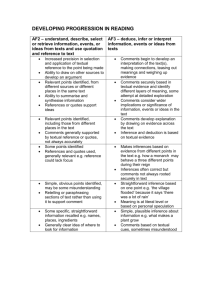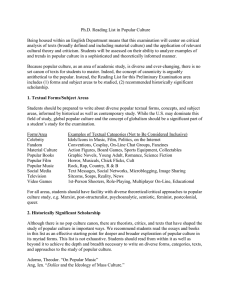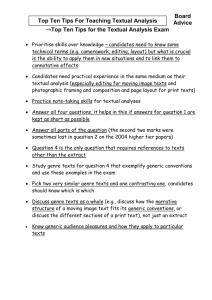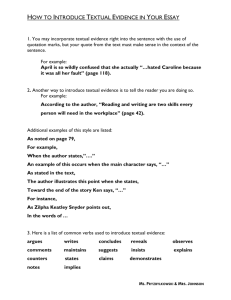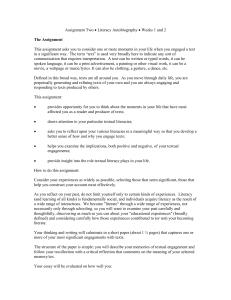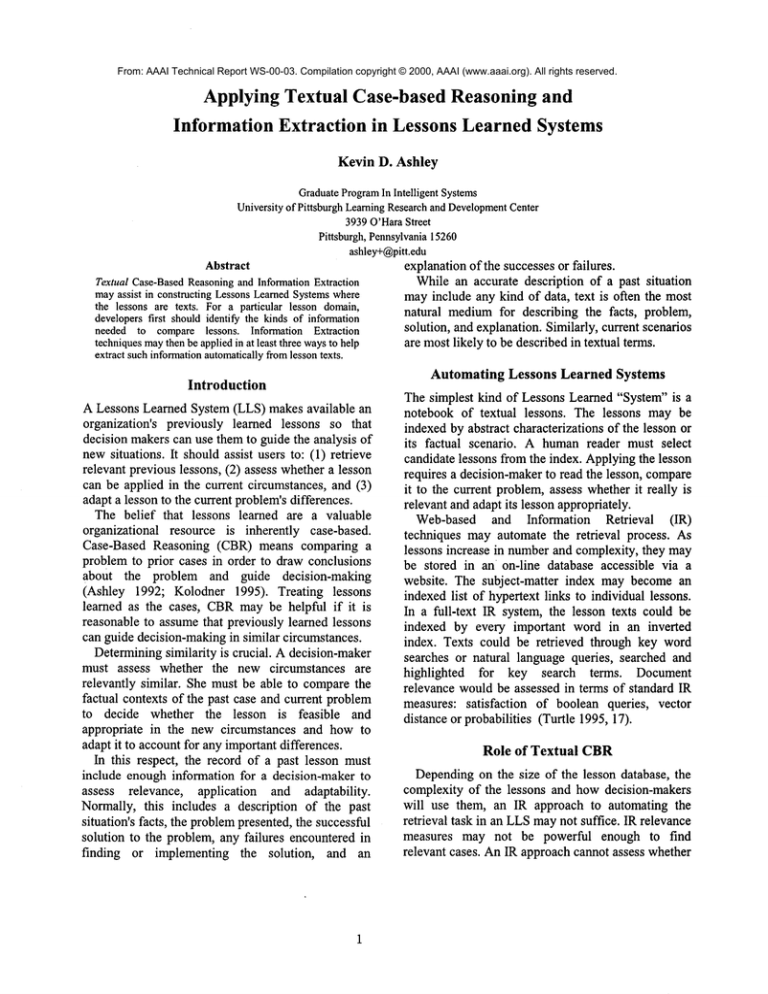
From: AAAI Technical Report WS-00-03. Compilation copyright © 2000, AAAI (www.aaai.org). All rights reserved.
Applying Textual Case-based Reasoning and
Information Extraction in Lessons Learned Systems
Kevin D. Ashley
GraduateProgramIn Intelligent Systems
University of Pittsburgh Learning Research and DevelopmentCenter
3939 O’HaraStreet
Pittsburgh, Pennsylvania15260
ashley+@pitt.edu
Abstract
Textual Case-Based Reasoningand Information Extraction
mayassist in constructing Lessons Learned Systemswhere
the lessons are texts. For a particular lesson domain,
developers first should identify the kinds of information
needed to compare lessons. Information Extraction
techniquesmaythen be applied in at least three waysto help
extract such informationautomaticallyfromlesson texts.
Introduction
A Lessons Learned System (LLS) makesavailable
organization’s previously learned lessons so that
decision makerscan use themto guide the analysis of
newsituations. It shouldassist users to: (1) retrieve
relevant previouslessons, (2) assess whethera lesson
can be applied in the current circumstances, and (3)
adapt a lesson to the current problem’sdifferences.
The belief that lessons learned are a valuable
organizational resource is inherently case-based.
Case-Based Reasoning (CBR) means comparing
problemto prior cases in order to drawconclusions
about the problem and guide decision-making
(Ashley 1992; Kolodner 1995). Treating lessons
learned as the cases, CBRmaybe helpful if it is
reasonable to assumethat previously learned lessons
can guide decision-makingin similar circumstances.
Determiningsimilarity is crucial. Adecision-maker
must assess whether the new circumstances are
relevantly similar. She must be able to comparethe
factual contexts of the past case and current problem
to decide whether the lesson is feasible and
appropriate in the new circumstances and how to
adapt it to accountfor anyimportantdifferences.
In this respect, the record of a past lesson must
include enoughinformation for a decision-maker to
assess relevance, application and adaptability.
Normally, this includes a description of the past
situation’s facts, the problempresented, the successful
solution to the problem, any failures encounteredin
finding or implementing the solution, and an
explanationof the successesor failures.
Whilean accurate description of a past situation
mayinclude any kind of data, text is often the most
natural mediumfor describing the facts, problem,
solution, and explanation.Similarly, current scenarios
are mostlikely to be describedin textual terms.
Automating Lessons Learned Systems
The simplest kind of Lessons Learned "System" is a
notebook of textual lessons. The lessons maybe
indexedby abstract characterizations of the lesson or
its factual scenario. A humanreader must select
candidate lessons from the index. Applyingthe lesson
requires a decision-makerto read the lesson, compare
it to the current problem,assess whetherit really is
relevant andadapt its lesson appropriately.
Web-based and Information Retrieval (IR)
techniques mayautomate the retrieval process. As
lessons increase in numberand complexity, they may
be stored in an on-line database accessible via a
website. The subject-matter index may becomean
indexedlist of hypertext links to individual lessons.
In a full-text IR system, the lesson texts could be
indexed by every important word in an inverted
index. Texts could be retrieved through key word
searches or natural language queries, searched and
highlighted for key search terms. Document
relevance wouldbe assessed in terms of standard IR
measures: satisfaction of boolean queries, vector
distance or probabilities (Turtle 1995,17).
Role of Textual CBR
Dependingon the size of the lesson database, the
complexity of the lessons and howdecision-makers
will use them, an IR approach to automating the
retrieval task in an LLSmaynot suffice. IR relevance
measures may not be powerful enough to find
relevant cases. An IR approachcannot assess whether
a case applies or howto adaptit.
An AI/CBRtechnique mayautomate retrieval with
a more knowledge-intensive relevance measure, one
which directly relates to the problem-solvingtasks
users need cases to perform. CBRrelevance criteria
relate to the domain-specificfeatures with whichto
compareand adapt cases to problemsituations. Using
these criteria,
the system could help assess
applicability andassist with adaptation.
To apply CBR,one must develop a frameworkfor
representing the case features that are important for
comparing and adapting cases. For convenience, I
will refer to this as the Case Representation
Framework (CRF). The CRF enables a computer
programto comparecases for purposes of assessing
relevance, applicability, andadaptation.
Factors, a device for representing important
features of legal cases (Aleven 1997; Ashley and
Aleven 1997), mayhave some utility in capturing
lesson learned. Factors represent stereotypical
patterns of facts in a case that strengthen or weaken
an argumentin favor of its conclusion. Factors may
correspondto the relative strengths and weaknesses,
benefits and costs, or pluses and minusesof following
one plan versus an alternative. Where, as often
happens, a case involves competing factors, a
successful decision in the case is someevidencethat
the strengths outweigh the weaknesses in similar
contexts. That maybe the "lesson" of the case.
Assessing whether it applies in a current problem
involves determining whether the same set of
conflicting factors is present, whether somefactors
are missing or new factors are present and their
significance. One must also consider background
changessince the previouslesson.
The traditional CBRapproach is problematic,
however. To apply the relevance criteria, cases must
be represented in the Case Representation Framework
so that the program can perform comparisons. This
meansthat the textual lessons must be translated or
mappedinto the CRF.Lacking general AI techniques
for understandingnatural language, case entry usually
is a time-consuming, manual process and a serious
knowledgeacquisition bottleneck. As a result, the
case databases of traditional CBRprogramsare tiny
comparedto IR databases. Similarly, one needs to
represent newproblemscenarios in the CRF.
Research in a new sub-field, Textual CBR(TCBR),
has addressed the challenges of a subset of CBR
domainswherecases are texts (i.e., textual cases)
(Ashley and Lenz 1998). Programs are under
developmentautomatically to: (1) assign indices
textual cases, (2) retrieve relevant cases, and (3)
extract or highlight relevant passagesin textual cases.
TCBRmayassist LLS developers to: (1) assign
indices to lessons automatically, (2) retrieve lessons
with relevancecriteria directly related to howa lesson
maysolve a newproblem,and (3) highlight parts of
lesson that are mostrelevant for assessing whetherit
applies and howto adapt it.
Significantly, TCBR
techniques do not obviate the
need for a Case Representation Framework. While
some TCBRretrieval techniques do not require a
highly elaborated CRF(e.g., Burke, et al. 19971;Lenz
and Burkhard1997), systemsthat learn automatically
to index or highlight cases still do require a CRF,
both to process texts and reasonwith cases.
Animportant initial question for LLSdesigners,
then, is what kind of Case Representation Framework
their particular domain/taskrequires. Howdo/should
decision-makers comparethe current problem with
past lesson scenarios to decide whether a lesson
applies and how to adapt it? On what kinds of
features do the comparisons turn? Answeringthese
questions will help in designing appropriate CRFs
and should be a major focus of the Workshop.
Role of Information Extraction
Once an LLS designer has settled upon a Case
Representation Framework,the kind of information
to be extracted from the textual lessons becomes
clear. For purposesof discussion, let us assumethat
factors are part of the CRF.
Recent work on Information Extraction (IE) may
be useful. IE comprises knowledge-basedtechniques
for extracting information from a corpus of texts
within a particular domainof discourse (Riloff 1996;
1993). Typically, IE programsapply a dictionary of
concept nodes, specially-generated from the corpus,
to extract information from newtexts. Eachconcept
node is a frame of information. Triggered by the
appearance of a particular word in a newtext, the
concept node tells the IE programwhich additional
features to look for in the text. For instance, a concept
i FAQFINDER
(Burke,et al. 1997)is a natural language
question-answering system based on USENET
files of
frequently-asked
questions.Givena query,it retrieves the
mostsimilar Q/Apair fromthe mostappropriateFAQ
file.
Since lessons learned and FAQsmaybe similar, FAQ
FINDER
maybe a useful prototypefor LLSs.
node named"target-subject-passive-verb-kidnapped"
is triggered whenthe IE programencounters the term
"kidnapped"in a passive voice construction, as in "A
U.S. diplomat was kidnapped by FMLN
guerillas
today." (Riloff 1993, 812). The concept node frame
tells the programto look for a sentencesubject of the
class human,the person who was kidnapped, and a
prepositional phrasereferring to the kidnappers.
Recently, the all-important conceptdictionaries can
be produced automatically, or semi-automatically.
For example, AutoSlog-TScan identify an ordered
list of short phrasesthat are characteristic of a corpus
of relevant documentsfrom whicha humancan select
the best phrases for adding to the dictionary (Riloff
1996).
The question is whether IE can extract from a
textual lesson data to fill out a Case Representation
Framework. Can it extract factors? Factors are
sentence-length concepts more complexthan those
that IE has succeededin extracting. Thelesson texts,
although not as complex as, say, legal opinions,
probably are more complexthan newspaperarticles,
the typical texts to whichIE has beenapplied.
In work on the SMILEprogram (Smart Index
LEarner) we apply AutoSlog-TSto help the program
learn to extract information about particular factors
from textual cases. SMILE
learns to assign factors to
legal opinions involving trade secret law. It employs
a machinelearning algorithm, ID3, to leam decision
trees for makingthe assignments.
The SPIREprogram (Daniels and Rissland 1997)
takes a different approach to a similar task,
highlightingfactor-like descriptionsin texts.
In SMILE,the training instances comefrom factual
case summariesin whichfactors have been identified
manually. Sentences from which it maybe directly
inferred that a factor applies are positive instances.
All other sentences are negative instances. An
exampleof one of the factors is F 15, Unique-Product.
A plaintiff’s claim for trade secret misappropriationis
strengthenedto the extent that the "Plaintiff wasthe
only manufacturer making the product." Figure 1
showsfour positive instances of Factor F 15.
ID3 learns a decision tree for a factor by
recursively partitioning the training set to best
discriminate the positive instances like those in
Figure 1 and the negative instances.
For this factor, SMILE
inducedthe decision tree in
Figure 2. Thedecision tree summarizesa set of rules
for classifying sentences: If the term "unique " is
present then F15 applies; else if "known" and
3
"general" are present then F15 applies; else if
"capable"is present....
1. [Plaintiff]
introduced evidence that [plaintiffs
product] was a unique product in the industry. (from
Innovative v. Bowen)
2. It appears that one could not order [plaintiffs
product] in any establishment other than that of the
plaintiff. (from Masonv. Jack Daniel Distillery)
3. The information in the diagram is not generally
known to the public nor to any of [the plaintiff’s]
competitors. (from Tri-Tron v. Velto)
4. Several features of the process were entirely unique
in [product-type] manufacturing. (from Sperry Rand
v. Rothlein)
Figure1: Instancesof FactorFIS, Unique-Product
We have confirmed empirically that SMILE’s
decision trees do a better job of assigningfactors than
two reasonably intelligent baseline procedures
(BriJninghaus and Ashley 1999). Nevertheless, there
is room for improvement.For instance, SMILEdoes
not yet take negation into account. A product is
uniqueif it is not generally known;the decision tree
in Figure 2 does not makethat distinction.
..t
mm
se.
F15applies:
unique product
pres’ent
/"
~fies’ent
F15 applies:
info not generallyknown
absent
pres’ent
n,"
F15applies:
others not capable
to makeproduct
sent
pres’ent
~,/
F15applies:
novel product
Figure2: SMILE’s
DecisionTreefor FactorF15
To improvethe process of inducing decision trees, we
plan to use InformationExtraction in three ways.
First, weattempt to select the short phrases that
maybe the most effective concepts for ID3 to employ
in discriminating positive and negative instances of
the factors.
We apply AutoSlog-TS to two
collections: trade secret case texts wherethe relevant
factors are discussed and other, irrelevant cases.
AutoSlog-TS identifies
the phrases most
characteristic of the relevant documents.
Second, we employIE to extract from the cases
certain data associated with typical fact pattems. This
information can improve decision trees and help
control the complexity of learning. In a trade secret
case, the plaintiff
usually has developed some
confidential
product information and sues the
defendant for using that information to develop a
competing product. It is feasible to extract certain
role-playing
information
from such patterns,
including the parties’ names, their roles in the lawsuit
(i.e., plaintiff or defendant), the names of their
competing products, and possibly their product types.
In the training instances, one can then substitute the
more general role information for the specific names
of parties,
products, and product-types.
This
substitution
makes the training examples more
abstract and useful. By referring to role-playing
concepts like "plaintiff",
"defendant", "plaintiffs
product", and "product-type", the decision trees may
better discriminate positive and negative instances.
Instead of referring to specific names, unlikely to
appear in more than one case, the instances refer to
generic role-playing concepts, likely to appear over a
much wider range of cases. For example, in each of
the instances of factor F 15, Unique-Product, shownin
Figure 1, I manually substituted
role-playing
information for specific names. Originally, sentence 1
from the case of Innovative
v. Bowen stated,
"Innovative introduced evidence that Panl Brick was
a unique product in the industry." Decision trees
learned from more general examples like these will
better discriminate positive from negative instances.
The tree can relate the role information "plaintiffs
product" with "unique" to better capture the pattern
of concepts associated with the factor.
Third, the extracted
information
may focus
automatic text-processing on the most relevant parts
of a text. Parsing texts yields certain linguistic
information (e.g., about negation and phrases) that
would help SMILEdiscriminate positive and negative
instances of a factor. On the other hand, parsing
generates too manyfeatures and renders the learning
task too complex. It would help if the program could
select the most productive sentences to parse. Whena
textual case refers to the parties and products by
name, it is more likely that the court is discussing the
case’s specific facts. These parts of the text are more
likely to identify information from which it can be
inferred whether factors apply.
Conclusion
Textual Case-Based Reasoning programs like SMILE
apply Information Extraction techniques to extract
complex information like factors,
which may be
useful for comparing lessons. The IE techniques can
help in selecting representative phrases, extracting
information about typical fact patterns, and directing
more intense language processing to the most fruitful
parts of a text. These techniques may help construct
Lessons Learned Systems where the lessons are texts.
Developers, however, must first identify the kinds of
information needed to compare lessons.
References
Aleven, V. (1997) Teaching Case-Based Argumentation
through a Model and Examples, Ph.D. Dis. Intelligent
SystemsProg., U. Pittsburgh. www.cs.cmu.edu/~aleven
Ashley, K. D. (1992) Case-Based Reasoning and its
Implications for Legal Expert Systems". In Artificial
Intelligence and Law. Vol 1, No. 2, pp. 113-208.
Kluwer. Dordrecht, Netherlands.
Ashley, K. and V. Aleven. (1997) ReasoningSymbolically
AboutPartially MatchedCases. Int’l Joint Conf. on AI,
IJCAI-97. 335-341. MorganKaufmann:San Francisco.
Ashley, K.D. and Lenz, M. (eds.) (1998) Textual CaseBased Reasoning, Papers from the AAAI-98Workshop,
AAAI Tech. Rep. WS-98-12AAAIPress, MenloPark.
Brtininghaus, S. and K.D. Ashley (1999a) Bootstrapping
Case Base Development with Annotated Case
Summaries. In CBRResearch and Development: Proc.
3d Int’l Conf. on CBR.59-73. Lecture Notes in AI 1650.
Springer: Berlin. www.pitt.edu/~steffi/papers/iccbr99.ps
Burke, R., Hammond,K., Kulyukin, V., Lytinen, S.,
Tomuro, N. and Schoenberg, S. (1997) QuestionAnswering from Frequently-Asked Question Files:
Experiences
with the FAQ FINDER System, AI
Magazine18:2 57-66.
Daniels, J.J. and Rissland, E.L (1997) Whatyou saw
what you want: Using cases to seed information
retrieval, Proc. 2d Int’l Conf. on CBRCBRResearchand
Development ICCBR-97.325-336. Lecture Notes in AI
Series No.1266. Springer: Berlin.
Lenz, M. and Burkhard, H.-D. (1997) CBRfor Document
Retrieval: The FAIlQProject In CBRRes. and Devel.:
Proc. 2d Int’l Conf. on CBR,. ICCBR-97.84-93. Lecture
Notesin AI Series No. 1266. Springer: Berlin.
Kolodner, J. (1995) Case-Based Reasoning Morgan
Kaufmann:San Mateo, CA.
Riloff, E. (1996) Automatically Generating Extraction
Patterns from UntaggedText, Proc. 13th Nat’l Conf. on
,41, 1044-1049,AAAIPress/M1TPress. MenloPark, CA.
Riloff, E. (1993) AutomaticallyConstructing a Dictionary
for Information Extraction Tasks. In Proc. 11th Nat’l
Conf. on AL 811-816. AAAI/MIT
Press. MenloPark.
Turtle, H.R.(1995) "Text Retrieval in the Legal World"
Artificial Intelligence and Law, 3: 5-54. Kluwer:
Dordrect.

